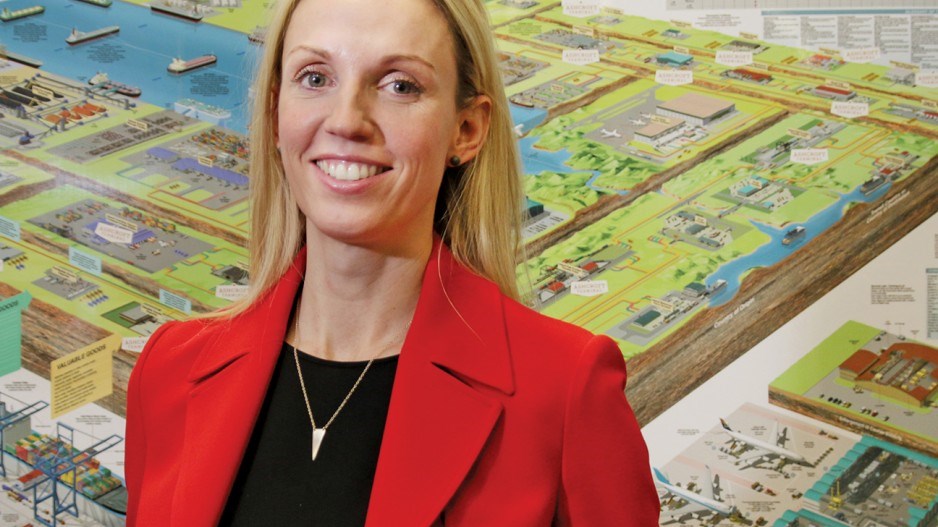Behind the reception desk at Ashcroft Terminal’s administrative office in Vancouver is an inspiringly Canadian painting.
Created by artist Jan Kasparec, the work depicts a lone, stationary train on a track through an alluring natural environment like that of British Columbia’s Interior.
The painting is an eloquent pairing of two interconnected themes: the rugged beauty of the Canadian landscape and the importance and reliance on movement across that landscape.
Movement and transportation help define Canadians’ way of life, and, says Kleo Landucci, managing director of Ashcroft Terminal, it’s time for the efficiency of goods movement within Canada to be elevated to a more sophisticated level.
Ashcroft Terminal is a 320-acre, privately owned inland transload and storage terminal with 350 acres of surrounding buffer land. It is located 340 kilometres east of Vancouver and 90 kilometres west of Kamloops, and it has direct access to major highways and railways. The terminal operates through a unique agreement between Canadian Pacific Railway Ltd. (TSX:CP) and Canadian National Railway Co. (TSX:CNR).
Landucci said the facility is one of the most ideally placed inland terminals to help alleviate some of the congestion problems facing goods movement in the Lower Mainland and to drive efficiency in a system riddled with redundancies.
“Ashcroft Terminal has the only property in the country with both CP and CN main lines running through it. We are uniquely positioned to be able to service the Lower Mainland and alleviate congestion and encroachment of industrial and agricultural land by moving some of those activities inland.”
The terminal is the creation of the Landucci family, which has a distinctly West Coast history. Kleo Landucci’s father, Robert Landucci, is the owner and CEO, and has been active in many of the sectors at the traditional centre of B.C.’s economy.
“My dad started as a commercial fisherman, then started his own lumber company in 1972. He’s also been involved in mining. Our family owns a small mine in the north, so he really had that background understanding of what it takes to get resource to market.”
“My grandfather immigrated here from Italy and spent 47 years working for what is now CP, so our background is in the Interior. It’s in our blood as to where the wealth is actually created – not in the city centres that support it, [but in] the hinterland, the mines, where the lumber is cut, where the products are produced.”
Landucci, 40, was raised on Vancouver’s North Shore, with the ocean as her backdrop. She attended Capilano University, but when a summer job at Canaccord Genuity Wealth Management turned into a full-time opportunity, she took the position and never looked back.
“I worked on the U.S. trading desk and I started a little web-based television show, before YouTube and smartphones.”
After gaining valuable corporate experience, she left the company to join the family business in 2004.
While many see problems facing the sector, Landucci sees possibilities, and embraces goods movement and strategy as her future.
“Well, I guess I am an optimist; there are terrific opportunities,” she said. “Look at the funding that’s coming from government into trade-enabling infrastructure. Certainly the federal government understands very clearly that there is a need to spend some money to help support trade through our critical gateways.”
Naturally, Landucci sees inland ports as a huge opportunity.
“Ours is a beautiful city; we are lucky to live here, but it’s not sustainable to be moving goods the way we have been moving goods.
“We see a lot of the production in Western Canada being driven or brought down inefficiently into the Lower Mainland and [which] needs to be transloaded here and put into containers to go to export – and that is a big cost to the producer.”
By operating as an effective storage facility connected to CP and CN main lines, Ashcroft stands to help producers cut costs and alleviate congestion.
“We look at doing things different,” Landucci said. “We look at doing things closer to source, and we look at the opportunities to alleviate those long-haul truck drives that are unnecessary.”
She illustrates her point by showing an image of the Lower Mainland criss-crossed by a spiderweb-like pattern of lines that highlight truck movement from various facilities.
“We have an opportunity to look at smart infrastructure investments that convert as much truck traffic to rail traffic as possible.”
At the same time, inland ports struggle with the same challenges facing the entire transportation sector.
“Population growth, density, wanting beautiful residences on land that was once industrial – we can’t keep upzoning these properties, losing industrial land, complaining about it and then not finding solutions,” she said.
Congestion has been a major concern in Metro Vancouver. The Canada Transportation Act Review Report identified it as one of the main hindrances in the sector over the next 20 years.
“Ashcroft is a really great solution for some [logistics problems],” she said. “We don’t claim to be able to do everything, but we can certainly help prepare goods because every single train, every single product that comes on every single boat has to pass through our terminal, so that gives us an opportunity to help get that product out.”
Asked about the transportation sector’s economic outlook, Landucci stressed the crucial importance of efficiency.
“The need to have efficient transportation supply chains is at an all-time high,” she said. “When we look at where transportation is going we know exports are generally growing. We know that imports are coming through our western coast ports; they are being fed into Canada and very focused into the midwest.”
The intricate problems that come with managing these movements are what excite Landucci.
“I love being strategic. I love looking at opportunities and then getting into the weeds and figuring it out, going from 30,000 feet down.”




